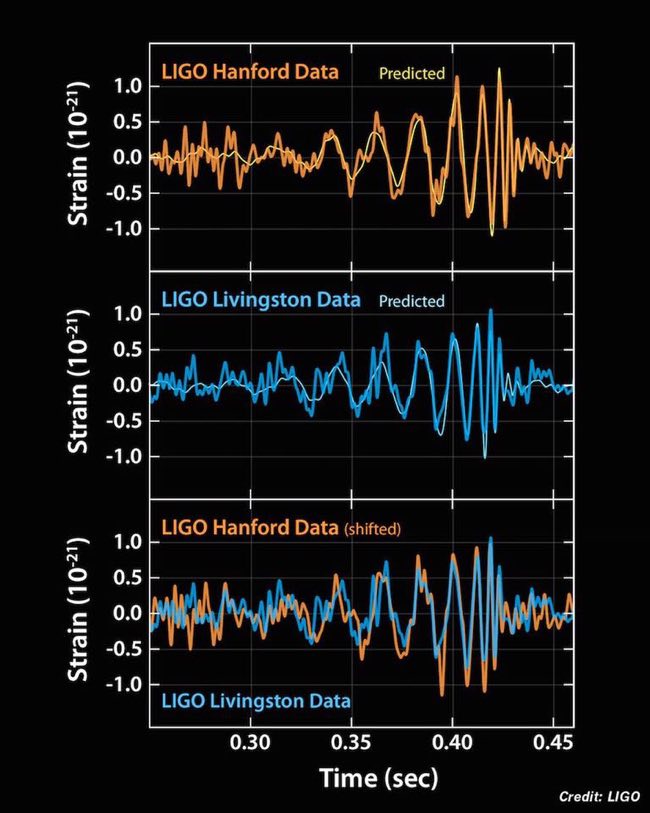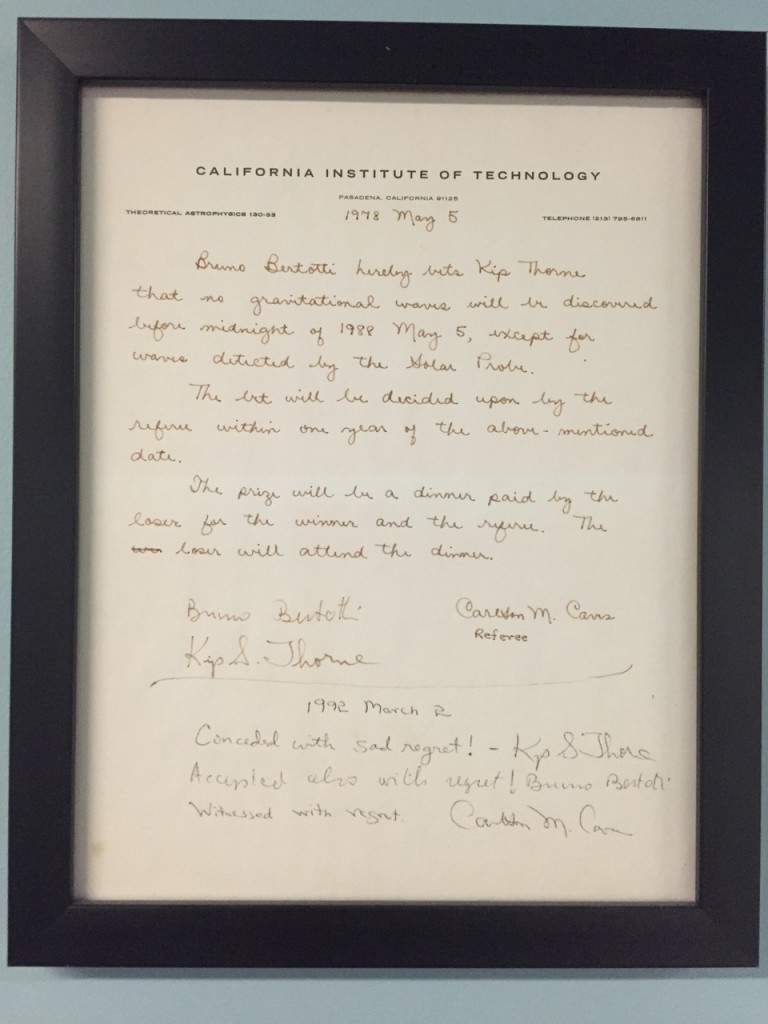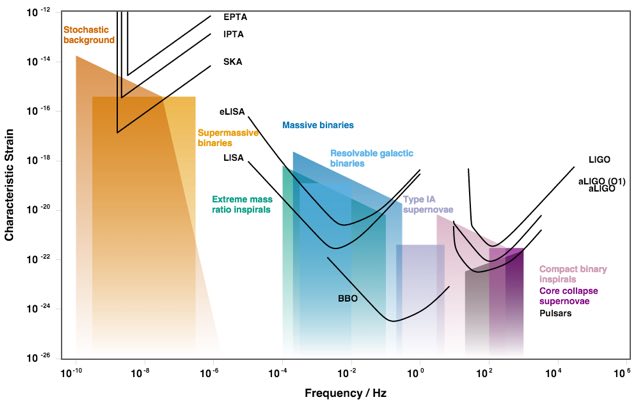ONCE upon a time, there lived a man who was fascinated by the phenomenon of gravity. In his mind he imagined experiments in rocket ships and elevators, eventually concluding that gravity isn’t a conventional “force” at all — it’s a manifestation of the curvature of spacetime. He threw himself into the study of differential geometry, the abstruse mathematics of arbitrarily curved manifolds. At the end of his investigations he had a new way of thinking about space and time, culminating in a marvelous equation that quantified how gravity responds to matter and energy in the universe.
Not being one to rest on his laurels, this man worked out a number of consequences of his new theory. One was that changes in gravity didn’t spread instantly throughout the universe; they traveled at the speed of light, in the form of gravitational waves. In later years he would change his mind about this prediction, only to later change it back. Eventually more and more scientists became convinced that this prediction was valid, and worth testing. They launched a spectacularly ambitious program to build a technological marvel of an observatory that would be sensitive to the faint traces left by a passing gravitational wave. Eventually, a century after the prediction was made — a press conference was called.
Chances are that everyone reading this blog post has heard that LIGO, the Laser Interferometric Gravitational-Wave Observatory, officially announced the first direct detection of gravitational waves. Two black holes, caught in a close orbit, gradually lost energy and spiraled toward each other as they emitted gravitational waves, which zipped through space at the speed of light before eventually being detected by our observatories here on Earth. Plenty of other places will give you details on this specific discovery, or tutorials on the nature of gravitational waves, including in user-friendly comic/video form.
What I want to do here is to make sure, in case there was any danger, that nobody loses sight of the extraordinary magnitude of what has been accomplished here. We’ve become a bit blasé about such things: physics makes a prediction, it comes true, yay. But we shouldn’t take it for granted; successes like this reveal something profound about the core nature of reality.
Some guy scribbles down some symbols in an esoteric mixture of Latin, Greek, and mathematical notation. Scribbles originating in his tiny, squishy human brain. (Here are what some of those those scribbles look like, in my own incredibly sloppy handwriting.) Other people (notably Rainer Weiss, Ronald Drever, and Kip Thorne), on the basis of taking those scribbles extremely seriously, launch a plan to spend hundreds of millions of dollars over the course of decades. They concoct an audacious scheme to shoot laser beams at mirrors to look for modulated displacements of less than a millionth of a billionth of a centimeter — smaller than the diameter of an atomic nucleus. Meanwhile other people looked at the sky and tried to figure out what kind of signals they might be able to see, for example from the death spiral of black holes a billion light-years away. You know, black holes: universal regions of death where, again according to elaborate theoretical calculations, the curvature of spacetime has become so pronounced that anything entering can never possibly escape. And still other people built the lasers and the mirrors and the kilometers-long evacuated tubes and the interferometers and the electronics and the hydraulic actuators and so much more, all because they believed in those equations. And then they ran LIGO (and other related observatories) for several years, then took it apart and upgraded to Advanced LIGO, finally reaching a sensitivity where you would expect to see real gravitational waves if all that fancy theorizing was on the right track.
And there they were. On the frikkin’ money.
Our universe is mind-bogglingly vast, complex, and subtle. It is also fantastically, indisputably knowable.

I got a hard time a few years ago for predicting that we would detect gravitational waves within five years. And indeed, the track record of such predictions has been somewhat spotty. Outside Kip Thorne’s office you can find this record of a lost bet — after he predicted that we would see them before 1988. (!)
But this time around I was pretty confident. The existence of overly-optimistic predictions in the past doesn’t invalidate the much-better predictions we can make with vastly updated knowledge. Advanced LIGO represents the first time when we would have been more surprised not to see gravitational waves than to have seen them. And I believed in those equations.
I don’t want to be complacent about it, however. The fact that Einstein’s prediction has turned out to be right is an enormously strong testimony to the power of science in general, and physics in particular, to describe our natural world. Einstein didn’t know about black holes; he didn’t even know about lasers, although it was his work that laid the theoretical foundations for both ideas. He was working at a level of abstraction that reached as far as he could (at the time) to the fundamental basis of things, how our universe works at the deepest of levels. And his theoretical insights were sufficiently powerful and predictive that we could be confident in testing them a century later. This seemingly effortless insight that physics gives us into the behavior of the universe far away and under utterly unfamiliar conditions should never cease to be a source of wonder.
We’re nowhere near done yet, of course. We have never observed the universe in gravitational waves before, so we can’t tell for sure what we will see, but plausible estimates predict between one-half and several hundred events per year. Hopefully, the success of LIGO will invigorate interest in other ways of looking for gravitational waves, including at very different wavelengths. Here’s a plot focusing on three regimes: LIGO and its cousins on the right, the proposed space-based observatory LISA in the middle, and pulsar-timing arrays (using neutron stars throughout the galaxy as a giant gravitational-wave detector) on the left. Colorful boxes are predicted sources; solid lines are the sensitivities of different experiments. Gravitational-wave astrophysics has just begun; asking us what we will find is like walking up to Galileo and asking him what else you could discover with telescopes other than moons around Jupiter.
For me, the decade of the 2010’s opened with five big targets in particle physics/gravitation/cosmology:
- Discover the Higgs boson.
- Directly detect gravitational waves.
- Directly observe dark matter.
- Find evidence of inflation (e.g. tensor modes) in the CMB.
- Discover a particle not in the Standard Model.
The decade is about half over, and we’ve done two of them! Keep up the good work, observers and experimentalists, and the 2010’s will go down as a truly historic decade in physics.



“the first direct detection of gravitational waves. ”
unable to connect
Amazing! Congratulations to everyone involved.
Thank you for keeping us involved in such important moments via twitter and your blog, Dr. Carroll!
I have said it before and I say it again… What a wonderful time for being a physicist! Amazing, simply amazing…
Congrats to this species which has a lot to be ashamed of, but also, like today, a lot to be proud of. All that money spent, like this, is the only money really well spent. It means something.
GW are pure theoretical failure
http://www.nature.com/news/gravitational-waves-discovery-now-officially-dead-1.16830
I know this does not do all the theorising and practical invention justice, but hey, its just so damn cool.
From the conclusion of Amrit Sorli’s link:
“The latest findings do not mean that it is impossible to find evidence of gravitational waves in the microwave background — only that BICEP2 could not conclusively detect a signal amid the Galactic noise.
“There is a clear path forward,” says Kamionkowski. “If we do more measurements of this type at multiple frequencies, we will be able to separate out the dust signal from the [primordial] signal precisely” and do a more thorough search for gravitational waves.”
This is far from a “pure theoretical failure” and in no way supersedes the clear and conclusive evidence of gravitational waves produced by LIGO.
Sean, these GWs were detected by comparing the signal to the waveform template (theoretical expectation) for a black hole – black hole inspiral. Can LIGO ever detect something we DON’T expect, i.e something for which we don’t have a pre-existing theoretical template?
David — that would of course be much harder. But it’s possible if the signal is big enough. Having two detectors (and more, soon) is a crucial help here.
In addition to David Appell’s question: is the result a matter of “hineininterpretieren”of generally accepted view on gravitation or is it generic as far as the used methodology is concerned?
I can’t pretend to understand the science but, as an interested layperson, seeing the headline “Cosmic breakthrough: Scientists detect Einstein’s gravitational waves” on the Washington Post website made me cry.
Super cool, I was looking forward to the discovery of extra-dimensional gravitons that temporarily leak into the three visible space dimensions. This is strong evidence of string theory or M-theory 🙂
They probably just discovered a dust bunny from running this experiment for so long. Computer components wear out after time. Changes in temperature can change the impedance of resistors. A change in impedance can cause reflections of electromagnetic waves. It is really a miracle that they could accurately measure such distances for such a long period of time. I know I haven’t been able to have my own computer fan operate at top efficiently for only a couple of years…
Hi Sean, I have a question with some background context. For example, I suppose that “2. Directly detect gravitational waves” is tantamount to “5. Discover a particle not in the Standard Model.” In other words, I suppose that the direct detection of gravitational waves is the direct detection of gravitons that are not in the Standard Model. Do you agree or disagree with me? Peace, Jim
Stunning news indeed. Now, I have a question. I feel like the kid in school afraid to raise his hand and ask what may turn out to be a stupid question. But what the hell, here goes:
Why do the waves travel at the speed of light?
Sean,
What an amazing breakthrough! As an outsider to complexities of quantum theory, what implications does this have on certain interpretations of quantum mechanics?
-Feodor
And some people talk about “The End of Science” lol! Great achievement, and if I’m not mistaken there are THREE big discoveries here: as well as the first direct detection of gravitational waves we have the first observation of a black hole and also confirmation of General Relativity well into the strong-field dynamical regime.
The important point is that this is the FIRST TIME General Relativity has been directly tested in the strong field regime, where gravitational waves have a very strong effect on the merging process, not just slowly draining the energy and angular momentum from an orbiting pair of pulsars.
@WiseApe: Not a stupid question at all. Unfortunately I can only answer half of it. They cannot travel faster than light because General Relativity incorporates Einstein’s Special Relativity which says that nothing can travel faster than light. Now, they could still be slower… they aren’t, because that’s what the equations say, but I don’t know enough details to be able to explain that in a meaningful way.
Wait a minute. Einstein claimed that gravity wasn’t a mysterious force but a manifestation of the shape of local spaces distorted by the masses embedded in them. If there are gravitational waves, that means that space is wavelike … oh, oh, my head hurts!
https://www.facebook.com/groups/1474724676191165/?fref=ts
Thanks JH – that’s where I’m at – I understand why they’re not faster, but not why they’re as fast.
I just noticed something odd in the plots of Strain vs Time. In the lower plot overlaying Hanford and Livingston signals, not only is the Hanford data shifted in time (~7 ms), but it’s flipped in “polarity” as well. Is this simply due to their definitions of Strain (such that Hanford Strain = – Livingston Strain), maybe due to the different orientations of the two interferometers? I’m not exactly sure how they define strain.
On a side note, it looks like this signal was fairly easily detected without having to assume a waveform based on relativistic modeling, and then match filtering with it. They’re readily apparent in the time series, and they would clearly peak just by doing a cross-correlation from the two sites – no model assumptions needed. It was my impression that they primarily used the model waveform to be able to distinguish between two black holes, two neutron stars, or black hole-neutron star cases, as well as obtain estimates of masses, distance, etc. I may be wrong, though.
One of the best PRLs I have read in my life. I am 99.9% convinced…mostly, if I recall correctly, I solved a problem in MTW (Gravitation) for gravity waves. LIGO confirms textbook result.
A little luck they may see one again before I die. Alas, it is good for our species to live in a quiet galaxy (not as good for LIGO).
Well written. Compliments!
@ James Goatz
Watch the video! The detection of gravitational waves directly is just the same as if they detected a difference in the speed of light in the Michelson & Morley experiment, but on a more precise scale. It has nothing to do with detecting gravitons directly.